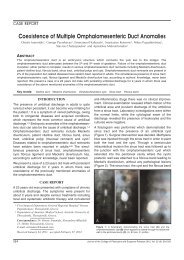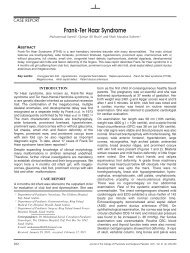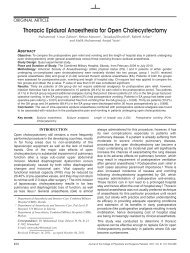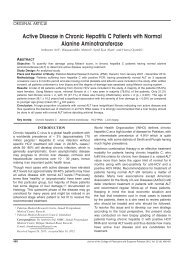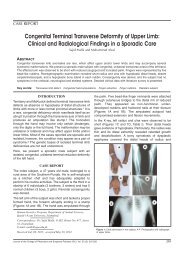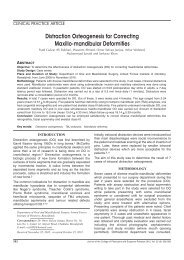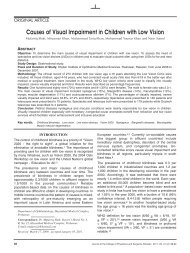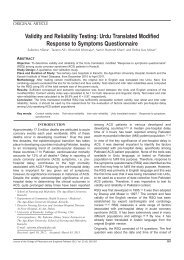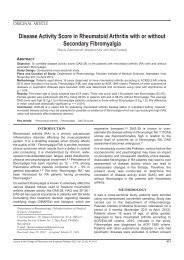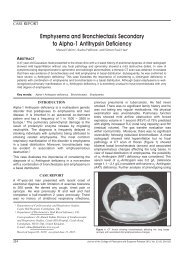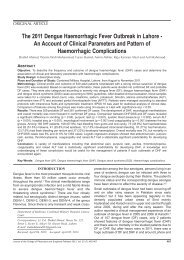Outcomes of Silicone Oil Removal - Journal of the College of ...
Outcomes of Silicone Oil Removal - Journal of the College of ...
Outcomes of Silicone Oil Removal - Journal of the College of ...
You also want an ePaper? Increase the reach of your titles
YUMPU automatically turns print PDFs into web optimized ePapers that Google loves.
ORIGINAL ARTICLE<strong>Outcomes</strong> <strong>of</strong> <strong>Silicone</strong> <strong>Oil</strong> <strong>Removal</strong>Shakir Zafar, Syeda Aisha Bokhari, Zeeshan Kamil, Munira Shakir, Syed Fawad Rizvi and Ghulam Mustafa MemonABSTRACTObjective: To evaluate <strong>the</strong> outcome and complications <strong>of</strong> removal <strong>of</strong> silicone oil after pars plana vitrectomy.Study Design: Case series.Place and Duration <strong>of</strong> Study: Layton Rahmatullah Benevolent Trust (L.R.B.T), Free Base Eye Hospital, Karachi, fromFebruary 2008 to January 2011.Methodology: Ninety five eyes <strong>of</strong> 95 patients with a history <strong>of</strong> undergoing three-port pars plana vitrectomy were includedin this study that subsequently underwent removal <strong>of</strong> silicone oil. <strong>Silicone</strong> oil was removed after ophthalmoscopicallydetermining retina attachment or when <strong>the</strong> duration <strong>of</strong> silicone oil tamponade was atleast <strong>of</strong> 6 months. Patients werefollowed for a period <strong>of</strong> 12 months.Results: Retinal re-detachment was seen in 19 (20%) out <strong>of</strong> 95 eyes, vitreous haemorrhage in 2 (2.1%) out <strong>of</strong> 95 eyes,corneal decompensation in 6 (6.3%) out <strong>of</strong> 95 eyes, hypotony in 7 (7.3%) out <strong>of</strong> 95 eyes, phthisis bulbi in 2 (2.1%) out <strong>of</strong>95 eyes and lens opacification in 9 (9.4%) out <strong>of</strong> 95 eyes.Conclusion: In this study, silicone oil removal resulted in various complications among which retinal re-detachment was<strong>the</strong> most frequent.Key Words: Complications. Proliferative vitreoretinopathy. <strong>Silicone</strong> oil removal. Tractional retinal detachment.INTRODUCTION<strong>Silicone</strong> does not occur naturally in free form, in itscombined form it accounts for about 25% <strong>of</strong> <strong>the</strong> earth'scrust. <strong>Silicone</strong> compounds are unique materials both interms <strong>of</strong> <strong>the</strong> chemistry and in <strong>the</strong>ir wide range <strong>of</strong> usefulapplications. <strong>Silicone</strong> in combination with organiccompounds provides unique properties that functionover a wide temperature range, making <strong>the</strong> siliconebased products less temperature sensitive than mostorganic surfactants. 1<strong>Silicone</strong> oil is used in vitreoretinal surgery to providelong-term internal tamponade in cases <strong>of</strong> complicatedretinal detachment. It is generally removed after 3months if <strong>the</strong> retina is attached and also must beremoved upon <strong>the</strong> development <strong>of</strong> oil emulsification,keratopathy, secondary glaucoma or cataract. 2 Theincidence <strong>of</strong> oil related complications has beenconstantly reduced by <strong>the</strong> development <strong>of</strong> highly viscousand highly purified oils as well as by refined operatingtechniques. 3Combined with vitreoretinal surgery, silicon oil injectionhas become a standard technique and improves <strong>the</strong>prognosis <strong>of</strong> complex retinal detachment associatedwith proliferative vitreoretinopathy, giant retinal tears,proliferative diabetic retinopathy, or ocular trauma.Compared with sulphur hexafluoride gas (SF6) as anDepartment <strong>of</strong> Ophthalmology, Layton RahmatullahBenevolent Trust (L.R.B.T), Free Base Eye Hospital, Karachi.Correspondence: Dr. Shakir Zafar, House No. 61, LRBT FreeEye Hospital, Korengi 2 1/2, Karachi.E-mail: drshakirzafar@yahoo.comReceived: July 07, 2012; Accepted: March 19, 2013.intraocular tamponade for <strong>the</strong> management <strong>of</strong> retinaldetachment, eyes treated with silicone oil were morelikely to be successfully re-attached, to achieve a bettervisual acuity, and to have fewer postoperative complications,particularly cataract, glaucoma, and keratopathy.4The rationale <strong>of</strong> this study was to report <strong>the</strong> outcomes <strong>of</strong>removal <strong>of</strong> silicone oil in a series <strong>of</strong> patients in a tertiarycare hospital.The objective <strong>of</strong> <strong>the</strong> study was to evaluate <strong>the</strong> outcomeand complications <strong>of</strong> removal <strong>of</strong> silicone oil after parsplana vitrectomy.METHODOLOGYThe records <strong>of</strong> 95 eyes <strong>of</strong> 95 consecutive patients whounderwent silicone oil removal between February 2008to January 2011 were reviewed. This study wasapproved by hospital ethical review committee. Allsurgeries were done by a pair <strong>of</strong> surgeon (SZ and MS).Patients with pseudohypopyon, un-controlled intraocularpressure and attached retina for more than 2 years wereincluded. Patients with PVR grade-C, optic atrophy andtotal retinal detachment were excluded. Criteria toremove <strong>the</strong> silicone oil were a completely attached retinaas determined ophthalmoscopically, and <strong>the</strong> duration <strong>of</strong>silicone oil tamponade was at least 6 months.The data acquisition was performed by two investigators(SAB and ZK) independently <strong>of</strong> <strong>the</strong> surgeon, whereas,pr<strong>of</strong>orma from <strong>the</strong> patients was ga<strong>the</strong>red by residentmedical <strong>of</strong>ficer (GMM). The study was conducted under<strong>the</strong> supervision <strong>of</strong> hospital incharge (SFR). In allpatients, silicone oil with a viscosity <strong>of</strong> 1000 centistokeswas used. Depending on <strong>the</strong> intraoperative situation,476 <strong>Journal</strong> <strong>of</strong> <strong>the</strong> <strong>College</strong> <strong>of</strong> Physicians and Surgeons Pakistan 2013, Vol. 23 (7): 476-479
<strong>Outcomes</strong> <strong>of</strong> silicone oil removaladditional procedures performed during pars planavitrectomy included use <strong>of</strong> an encircling band,membrane peeling, endo-drainage <strong>of</strong> subretinal fluid,use <strong>of</strong> perfluorocarbon liquids, endolaser coagulation,cryopexy, relaxing retinotomies, and cataract surgery. Allpatients were observed for complications for next 12months.The statistical analysis <strong>of</strong> <strong>the</strong> data was done by <strong>the</strong>s<strong>of</strong>tware Statistical Package for Social Sciences (SPSS)version 17. Descriptive statistics was calculated in terms<strong>of</strong> mean, standard deviation, minimum, maximum andrange. Mean and standard deviation were calculated forquantitative variable like age <strong>of</strong> <strong>the</strong> patients. Frequencyand percentage were calculated for gender, route <strong>of</strong>removal <strong>of</strong> silicone oil, complications and indications <strong>of</strong>retinal detachment surgery.RESULTSThis series included 50 (52.6%) male patients and 45(47.4%) female patients. The mean age was 39.10 ±10.26 years ranging from 21 to 60 years. Indications forpars plana vitrectomy were tractional retinal detachmentsecondary to diabetic retinopathy in 58 (61.1%) eyes,and proliferative vitreoretinopathy <strong>of</strong> grade-C or D in 37(38.9%) eyes. <strong>Silicone</strong> oil was removed via pars planasclerotomies in 87 (91.5%) eyes. Two pars plana portswere made; one at 6 O'clock position and <strong>the</strong> o<strong>the</strong>r at12 O'clock. The 6 O'clock port was used for irrigationwhereas <strong>the</strong> superior port was used for silicone oilremoval. In <strong>the</strong> remaining 8 (8.5%) eyes, which wereaphakic, silicone oil was removed through <strong>the</strong> pupil.<strong>Silicone</strong> oil removal was performed under generalanaes<strong>the</strong>sia in 9 (9.5%) <strong>of</strong> eyes, and under localanaes<strong>the</strong>sia in 86 (90.5%) <strong>of</strong> eyes.Out <strong>of</strong> 95 eyes undergoing silicone oil removal, a total <strong>of</strong>19 (20%) developed a retinal re-detachment aftersilicone oil removal (Figure 1a). The cause <strong>of</strong> redetachmentincluded development <strong>of</strong> anteriorproliferative vitreoretinopathy due to traction and newretinal breaks in 11 out <strong>of</strong> 19 (57.8%) eyes; reproliferationsbehind <strong>the</strong> equator with tractional retinaldetachment in 3 out <strong>of</strong> 19 (15.7%) eyes; tractional retinalTable I: Age (n = 95).Variable Mean SD Minimum Maximum RangeAge (years) 39.10 10.26 21 60 39detachment secondary to new proliferations in diabeticeyes in 5 out <strong>of</strong> 19 (26.3%, Figure 1b). Among <strong>the</strong>se 19patients with re-detachment, 11 (57.8%) presented withre-detachment within first week postoperatively, 5(26.3%) eyes presented within 4 weeks postoperatively,and 3 (15.7%) eyes presented within 8 weeks postoperatively.All 19 eyes were re-operated. In 15 eyesrevision surgery consisted <strong>of</strong> re-vitrectomy, retinectomy,membrane peeling with replacement <strong>of</strong> 5000 cs siliconeoil. Re-vitrectomy with temporary perfluorocarboninstillation and intraocular gas injection was successfullyperformed in 3 eyes, whereas, cryo<strong>the</strong>rapy andadditional scleral buckling were performed in 2 eyes.Cataract formation was observed in 9 (9.4%) out <strong>of</strong> 95eyes, mostly within <strong>the</strong> first 6 months. All eyesunderwent cataract extraction and implantation <strong>of</strong>posterior chamber lens.Corneal decompensation was seen in 6 (6.3%) <strong>of</strong> 95eyes (Figure 1c), because <strong>the</strong> oil had entered <strong>the</strong>anterior chamber and had been in contact with <strong>the</strong>corneal endo<strong>the</strong>lium. All <strong>the</strong>se patients were treated withpenetrating keratoplasty, later on.Postoperative hypotony (< 8 mmHg) occurred in 7 out <strong>of</strong>95 (7.3%). In 2 eyes, it was accompanied by massivefibrin exudation with IOP below 5 mmHg. In 5 out <strong>of</strong> 7eyes, IOP returned to normal within 10 days. Two out <strong>of</strong>7 (28.5%) eyes became phthisic soon after oil removal(Figure 1d), out <strong>of</strong> which one eye subsequentlyunderwent enucleation with orbital implant.Figure 2: Distribution <strong>of</strong> complications (n = 95).Figure 1: Photographs <strong>of</strong> various complications; (a) Re-retinal detachment; (b) PVR secondary to new proliferation in diabetic eyes, (c) corneal decompensation,(d) phthisis bulbi.<strong>Journal</strong> <strong>of</strong> <strong>the</strong> <strong>College</strong> <strong>of</strong> Physicians and Surgeons Pakistan 2013, Vol. 23 (7): 476-479 477
Shakir Zafar, Syeda Aisha Bokhari, Zeeshan Kamil, Munira Shakir, Syed Fawad Rizvi and Ghulam Mustafa MemonVitreous haemorrhage was observed in one eye (2.1%).Distribution <strong>of</strong> complications is illustrated in Figure 2.DISCUSSION<strong>Silicone</strong> oil has been used in <strong>the</strong> treatment <strong>of</strong> complexretinal detachments for many years. 5 However, manyauthors have reported postoperative anterior segmentscomplications, such as cataract, glaucoma, andkeratopathy even after successful re-attachment <strong>of</strong> <strong>the</strong>retina. 6 The possibility <strong>of</strong> toxic effect <strong>of</strong> silicone oil on <strong>the</strong>retina remains controversial. 7 When silicone oil hasbeen used in conjunction with vitrectomy, it cansubsequently be removed easily via <strong>the</strong> pars plana inphakic eyes or via <strong>the</strong> limbus in aphakic eyes. It hasbeen suggested that many complications may beprevented or <strong>the</strong>ir progression arrested when <strong>the</strong>silicone oil is removed a few weeks or months aftersurgery. 8 There are few reports detailing <strong>the</strong> effects <strong>of</strong>removing it ei<strong>the</strong>r as a prophylactic measure or as a part<strong>of</strong> <strong>the</strong> management <strong>of</strong> established complications. 9There is no definitive agreement on <strong>the</strong> appropriate timeperiod and indication <strong>of</strong> silicone oil removal. However,<strong>the</strong> rate <strong>of</strong> retinal re-detachment after silicone oilremoval varies widely and appears to correlate with <strong>the</strong>underlying disease process and its severity. Theliterature on strategies <strong>of</strong> silicone oil removal, <strong>the</strong> rate <strong>of</strong>complications, and thus <strong>the</strong> risk- benefit ratio is scant. 10Therefore, for silicone oil removal, we rely on personalexperience and <strong>the</strong> rare studies <strong>of</strong> silicone oil removal.The reported incidence <strong>of</strong> re-detachment variesbetween 0% and 32%. 11,12 This variation is mostprobably due to marked differences in <strong>the</strong> number <strong>of</strong>eyes studied, <strong>the</strong> duration <strong>of</strong> follow-up after silicone oilremoval, and <strong>the</strong> underlying diseases. Anatomicalsuccess after silicone oil removal, defined as completeretinal attachment was achieved in 76 (80%) out <strong>of</strong> 95eyes in this study, whereas, retinal re-detachment aftersilicone oil removal was seen in <strong>the</strong> remaining 20%.Falkner reported 17.4% cases <strong>of</strong> re-detachment aftersilicone oil removal in <strong>the</strong>ir study. 13 Darakhshandareported 38% re-detachment after silicone oil removal. 14In ano<strong>the</strong>r study, <strong>the</strong> reported rate <strong>of</strong> re-detachmentafter silicone oil removal was 25.3%. 15 Scholda reported20.5% cases <strong>of</strong> retinal detachment in <strong>the</strong>ir study. 16Pavlovic commented that eyes with completely attachedretinas, <strong>the</strong> risk <strong>of</strong> complication and re-detachment aftersilicone oil removal is relatively low. 17 Lens changeswere observed in 9.4% <strong>of</strong> eyes in this study, whereasScholda reported 36.7% lens opacification after siliconeoil removal. 16 Nawrocki et al. found a cataract rate <strong>of</strong>44.4%. 18 Gonvers found a cataract rate <strong>of</strong> 78%. 19Rates <strong>of</strong> hypotony were reported between 5% and51.4% in <strong>the</strong> literature. 11,13 In this study, postoperativehypotony (IOP < 8 mmHg) was found in 7.3% <strong>of</strong> eyes, inwhich, 2 (2%) eyes ended up in phthisis. Falkner alsoreported phthisis in 0.9% <strong>of</strong> eyes in his study. 13 Bassatet al. reported 2 out <strong>of</strong> 67 eyes were hypotonus aftersilicone oil removal. 20 Literature review revealed rates <strong>of</strong>keratopathy in <strong>the</strong> range <strong>of</strong> 4.5 – 63%. 11,13 Scholdareported 8.4% <strong>of</strong> keratopathy in his study. 16 In <strong>the</strong>current study, keratopathy was observed in 6.3% <strong>of</strong>eyes. Vitreous haemorrhage was seen in 2.1% cases inthis study. Falkner reported 4.3% cases <strong>of</strong> vitreoushaemorrhage. 13CONCLUSIONThe occurrence <strong>of</strong> oil related complications has led to<strong>the</strong> tendency <strong>of</strong> its removal after a certain filling period,but various studies including <strong>the</strong> current one havereported different complications associated with siliconeoil removal which included retinal re-detachment inhigher percentage.REFERENCES1. O'Lenick AJ. Basic silicone chemistry: a review [Internet].1999. Available from: http://www.siliconespectator.com/articles/<strong>Silicone</strong>_Spectator_January_2009.pdf2. Nagpal M, Videkar R, Mehrotra N. Hybrid technique for siliconeoil removal. Retina Today 2011; 36-40.3. Scholda C, Egger S, Lakits A, Haddad R. <strong>Silicone</strong> oil removal:results, risks and complications. Acta Ophthalmol Scand 1997;75:695-9.4. Lucke K, Strobel B, Foerster M, Laqua H. Secondaryglaucoma after silicone oil surgery. Klin Monbl Augenheilkd1990; 196:205-9.5. Cibis PA, Becker B, Okun E, Canaan S. The use <strong>of</strong> liquidsilicone in retinal detachment surgery. Arch Ophthalmol 1962;68:590-9.6. Haut J, Ullern M, Chermet M, Van Effenterre G. Complications<strong>of</strong> intraocular injections <strong>of</strong> silicone combined with vitrectomy.Ophthalmologica 1980; 180:29-35.7. Ober RR, Blanks JC, Ogden TE, Pickford M, Minckler DS,Ryan SJ. Experimental retinal tolerance to liquid silicone.Retina 1983; 3:77-85.8. Leaver PK, Cooling RJ, Feretis EB, Lean JS, McLeod D.Vitrectomy and fluid/silicone-oil exchange for giant retinaltears: results at six months. Br J Ophthalmol 1984; 68:432-8.9. Cairns JD, Anand N. Combined vitrectomy, intraocularmicrosurgery and liquid silicone in <strong>the</strong> treatment <strong>of</strong> proliferativevitreoretinopathy. Aust J Ophthalmol 1984; 12:133-8.10. Kampik A, Gandorfer A. <strong>Silicone</strong> oil removal strategies. SeminOphthalmol 2000; 15:88-91.11. Azen SP, Scott IU, Flynn HW Jr, Lai MY, Topping TM, Benati L,et al. <strong>Silicone</strong> oil in <strong>the</strong> repair <strong>of</strong> complex retinal detachments.A prospective observational multicentre study. Ophthalmology1998; 105:1587-97.12. Scholda C, Egger S, Lakits A, Walch K, von Eckardstein E,Biowski R. Retinal detachment after silicone oil removal.Acta Ophthalmol Scand 2000; 78:182-6.13. Falkner CI, Binder S, Kruger A. Outcome after silicone oilremoval. Br J Ophthalmol 2001; 85:1324-7.14. Darakhshanda K, Ghayoor I. Outcome <strong>of</strong> silicone oil removal ineyes undergoing 3-port pars plana vitrectomy. Pak J Ophthalmol2011; 27:17-20.478 <strong>Journal</strong> <strong>of</strong> <strong>the</strong> <strong>College</strong> <strong>of</strong> Physicians and Surgeons Pakistan 2013, Vol. 23 (7): 476-479
<strong>Outcomes</strong> <strong>of</strong> silicone oil removal15. Jonas JB, Knorr HL, Rank RM, Budde WM. Retinal redetachmentafter removal <strong>of</strong> intraocular silicone oil tamponade. Br JOphthalmol 2001; 85:1203-7.16. Scholda C, Egger S, Lakits A, Haddad R. <strong>Silicone</strong> oil removal:results, risks and complications. Acta Ophthalmol Scand 1997;75:695-9.17. Pavlovic S, Dick B, Schmidt KG, Tomic Z, Latinovic S. Longtermoutcome after silicone oil removal. Ophthalmologe 1995;92:672-6.18. Nawrocki J, Ghoraba H, Gabel VP. Problems with silicone oilremoval. A study <strong>of</strong> 63 consecutive cases. Ophthalmologe1993; 90:258-63.19. Gonvers M. Temporary silicone oil tamponade in <strong>the</strong>management <strong>of</strong> retinal detachment with proliferative vitreoretinopathy.Am J Ophthalmol 1985; 100:239-45.20. Bassat IB, Desatnik H, Alhalel A, Treister G, Moisseiev J.Reduced rate <strong>of</strong> retinal detachment following silicone oilremoval. Retina 2000; 20:597-603.<strong>Journal</strong> <strong>of</strong> <strong>the</strong> <strong>College</strong> <strong>of</strong> Physicians and Surgeons Pakistan 2013, Vol. 23 (7): 476-479 479



